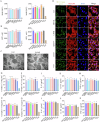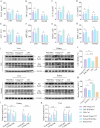Mitochondrial transplantation: adaptive bio-enhancement
- PMID: 40595522
- PMCID: PMC12218056
- DOI: 10.1038/s41419-025-07643-8
Mitochondrial transplantation: adaptive bio-enhancement
Abstract
Mitochondria, often referred to the powerhouse of the cell, are essential for cellular energy production, and their dysfunction can profoundly affect various organs. Transplantation of healthy mitochondria can restore the bioenergetics in diseased cells and address multiple conditions, but more potentials of this approach remain unclear. In this study, I demonstrated that the source of transplanted mitochondria is not limited by species, as exhibit no significant responses to mitochondria derived from different germlines. Moreover, I identified that metabolic compatibility between the recipient and exogenous mitochondria as a crucial factor in mitochondrial transplantation, which confers unique metabolic properties to recipient cells, enabling them to combat different diseases. Additionally, my findings indicated competitive interactions among mitochondria with varying functions, with more bioenergetic-active mitochondria yielded superior therapeutic benefits. Notably, no upper limit for the bioenhancement provided by exogenous mitochondria has been identified. Based on these insights, I proposes a novel therapeutic approach-adaptive bioenhancement through mitochondrial transplantation.
© 2025. The Author(s).
Conflict of interest statement
Competing interests: The author declares no competing interests. Ethics approval and consent to participate: The experimental animal facilities have been licensed by the Guangdong Medical Experimental Animal Center (SCXK-2021-0041). All methods were performed in accordance with the relevant guidelines and regulations.
Figures






Similar articles
-
Systemic pharmacological treatments for chronic plaque psoriasis: a network meta-analysis.Cochrane Database Syst Rev. 2021 Apr 19;4(4):CD011535. doi: 10.1002/14651858.CD011535.pub4. Cochrane Database Syst Rev. 2021. Update in: Cochrane Database Syst Rev. 2022 May 23;5:CD011535. doi: 10.1002/14651858.CD011535.pub5. PMID: 33871055 Free PMC article. Updated.
-
Synbiotics, prebiotics and probiotics for solid organ transplant recipients.Cochrane Database Syst Rev. 2022 Sep 20;9(9):CD014804. doi: 10.1002/14651858.CD014804.pub2. Cochrane Database Syst Rev. 2022. PMID: 36126902 Free PMC article.
-
Home treatment for mental health problems: a systematic review.Health Technol Assess. 2001;5(15):1-139. doi: 10.3310/hta5150. Health Technol Assess. 2001. PMID: 11532236
-
Systemic pharmacological treatments for chronic plaque psoriasis: a network meta-analysis.Cochrane Database Syst Rev. 2017 Dec 22;12(12):CD011535. doi: 10.1002/14651858.CD011535.pub2. Cochrane Database Syst Rev. 2017. Update in: Cochrane Database Syst Rev. 2020 Jan 9;1:CD011535. doi: 10.1002/14651858.CD011535.pub3. PMID: 29271481 Free PMC article. Updated.
-
Single-incision sling operations for urinary incontinence in women.Cochrane Database Syst Rev. 2017 Jul 26;7(7):CD008709. doi: 10.1002/14651858.CD008709.pub3. Cochrane Database Syst Rev. 2017. Update in: Cochrane Database Syst Rev. 2023 Oct 27;10:CD008709. doi: 10.1002/14651858.CD008709.pub4. PMID: 28746980 Free PMC article. Updated.
References
-
- Emani SM, Piekarski BL, Harrild D, Del Nido PJ, McCully JD. Autologous mitochondrial transplantation for dysfunction after ischemia-reperfusion injury. J Thorac Cardiovasc Surg. 2017;154:286–9. - PubMed
-
- McCully JD, Cowan DB, Emani SM, Del Nido PJ. Mitochondrial transplantation: from animal models to clinical use in humans. Mitochondrion. 2017;34:127–34. - PubMed
-
- Gorick C, Debski A. Mitochondrial transplantation for ischemic heart disease. Nat Nanotechnol. 2024;19:1247–1248. - PubMed
MeSH terms
LinkOut - more resources
Full Text Sources

